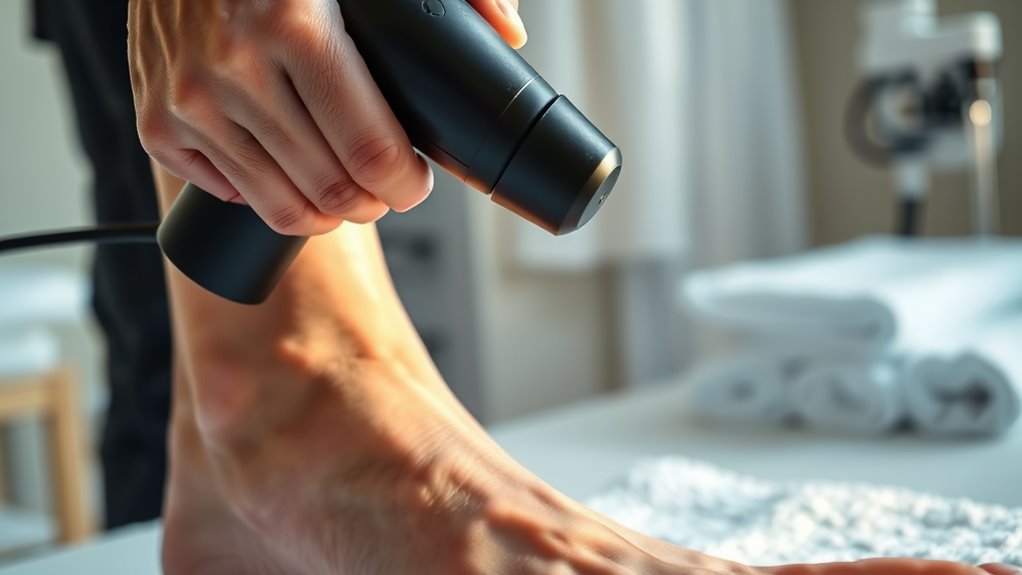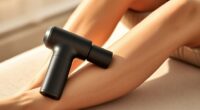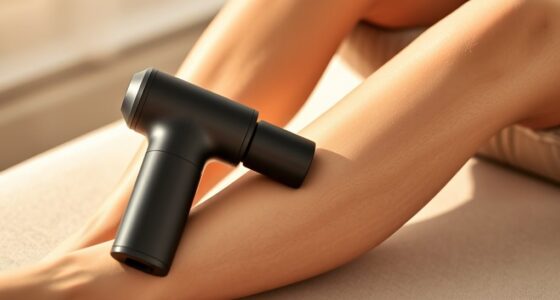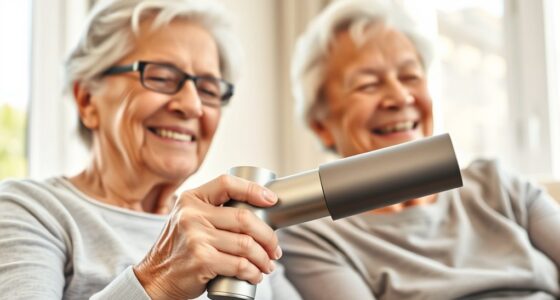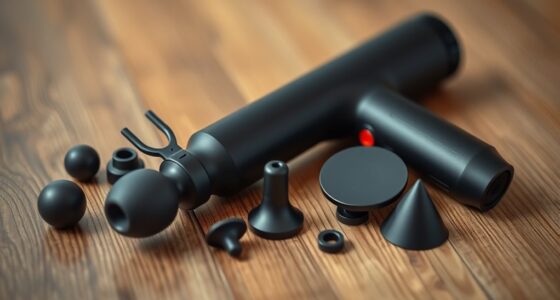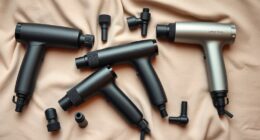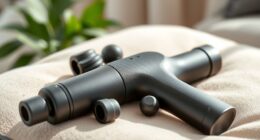A massage gun might temporarily relieve plantar fasciitis by easing tightness and improving blood flow, but its effectiveness is limited without proper technique and other treatments. It’s important to use the device carefully, avoid bony or swollen areas, and combine it with stretching and professional advice. While some find relief, scientific evidence is limited. If you want to explore safe, effective ways to manage your heel pain, there’s more to learn below.
Key Takeaways
- Evidence supporting massage guns for plantar fasciitis is limited; they may provide temporary symptom relief.
- Proper technique and cautious use are essential to avoid aggravating foot pain or causing injury.
- Combining massage gun therapy with stretching and professional treatments offers a more comprehensive approach.
- Physiotherapists recommend using massage guns as a complementary tool, not a standalone solution.
- Always consult a healthcare professional before incorporating massage guns into your plantar fasciitis management plan.
Understanding Plantar Fasciitis and Its Causes
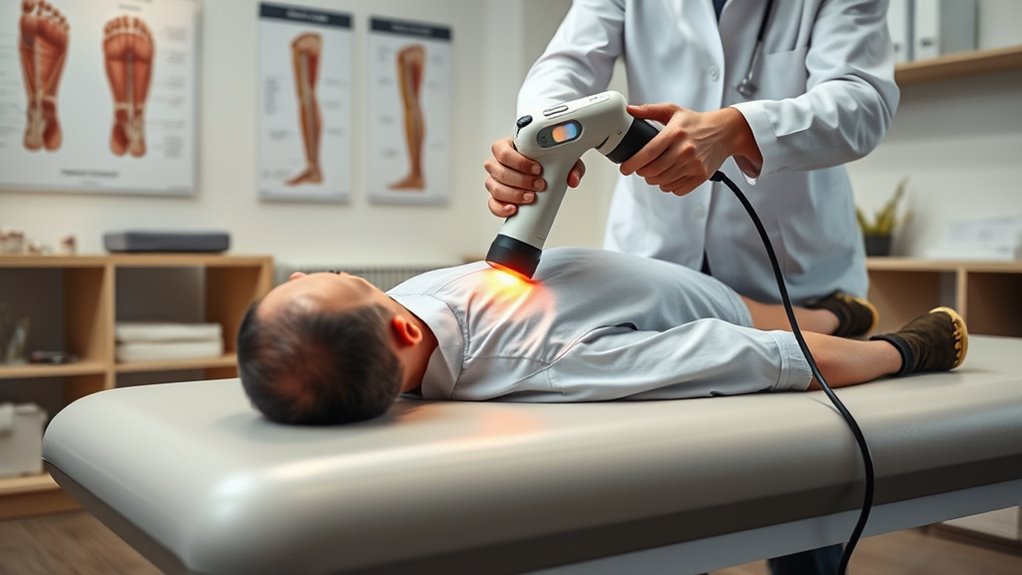
Plantar fasciitis is a common cause of heel pain that occurs when the thick band of tissue running along the bottom of your foot becomes inflamed or damaged. This condition often stems from issues with foot biomechanics, such as flat feet, high arches, or abnormal gait patterns, which put extra stress on the plantar fascia. When your foot’s biomechanics aren’t ideal, they cause uneven pressure distribution, leading to heel inflammation. Over time, repetitive strain weakens the tissue, resulting in sharp pain, especially after rest or in the morning. Recognizing how foot biomechanics contribute to plantar fasciitis helps you understand why the heel becomes inflamed and why addressing these underlying issues is key to effective treatment. Additionally, diverse beach experiences across different regions can influence foot health, particularly if engaging in activities like walking on uneven surfaces or participating in water sports that may exacerbate foot strain.
How Massage Guns Work and Their Typical Uses
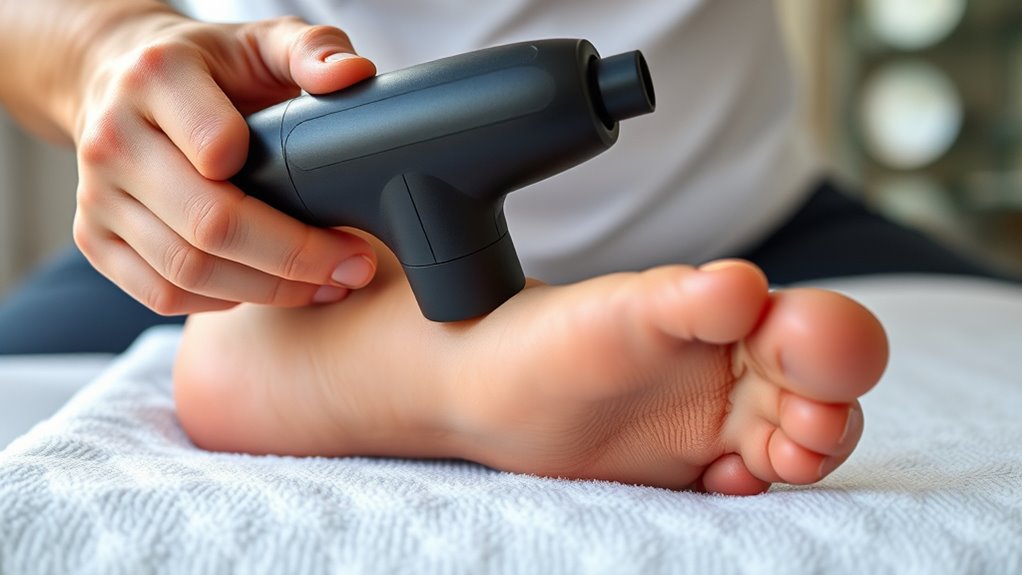
Massage guns are handheld devices that deliver rapid, percussive pulses to targeted muscles, helping to relax tension and reduce soreness. They work by stimulating muscle tissue, promoting blood flow, and easing tightness. You can use them on various muscle groups to break up trigger points, those knots or tight spots that cause pain or discomfort. The percussive action helps release muscle tightness, improving flexibility and reducing pain. Massage guns are versatile tools often used for warm-up before exercise, post-workout recovery, or to relieve everyday muscle tension. They’re especially helpful if you experience localized soreness or muscle tightness, as they allow you to target specific areas quickly and effectively. Additionally, understanding trigger points can help optimize their use for pain relief. Just remember to use them carefully to avoid overstimulation or injury.
What Does the Evidence Say About Massage Guns for Foot Pain?
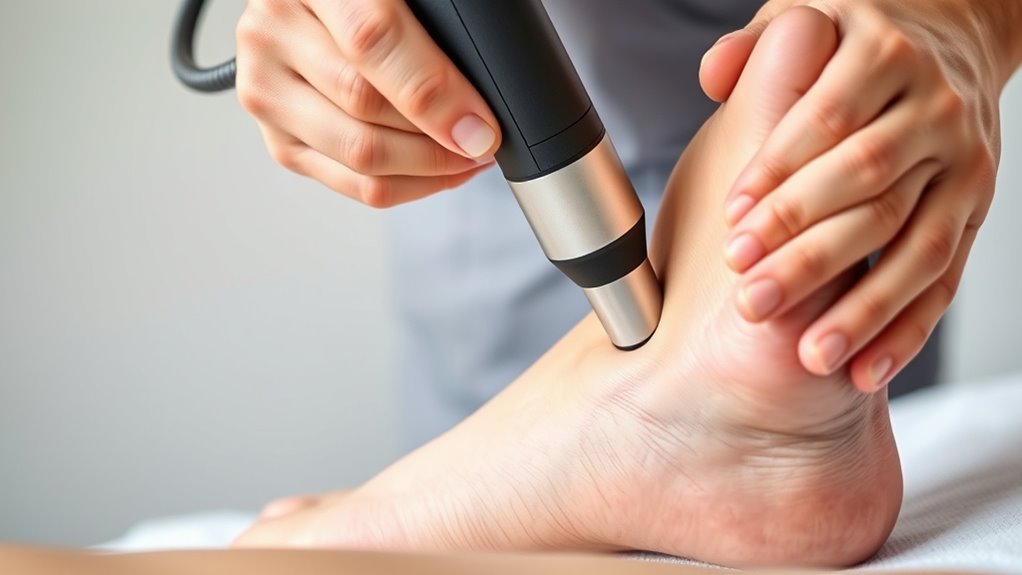
While massage guns are popular for easing muscle tension elsewhere in the body, their effectiveness for foot pain remains a subject of ongoing research. Currently, evidence supporting their use for plantar fasciitis or other foot conditions is limited. Some studies suggest that massage therapy can provide temporary relief, but whether massage guns offer similar benefits is still uncertain. As you consider alternative therapies, it’s important to evaluate device safety—ensuring you use the device correctly to avoid injury. While some users report pain reduction and improved mobility, scientific support is not conclusive. More rigorous research is needed to determine if massage guns truly help with foot pain, making them a complementary option rather than a primary treatment. Additionally, understanding Essential Oils for Plantar Fasciitis may offer alternative or supportive relief strategies.
Physiotherapist’s Perspective on Using Massage Guns for Plantar Fasciitis
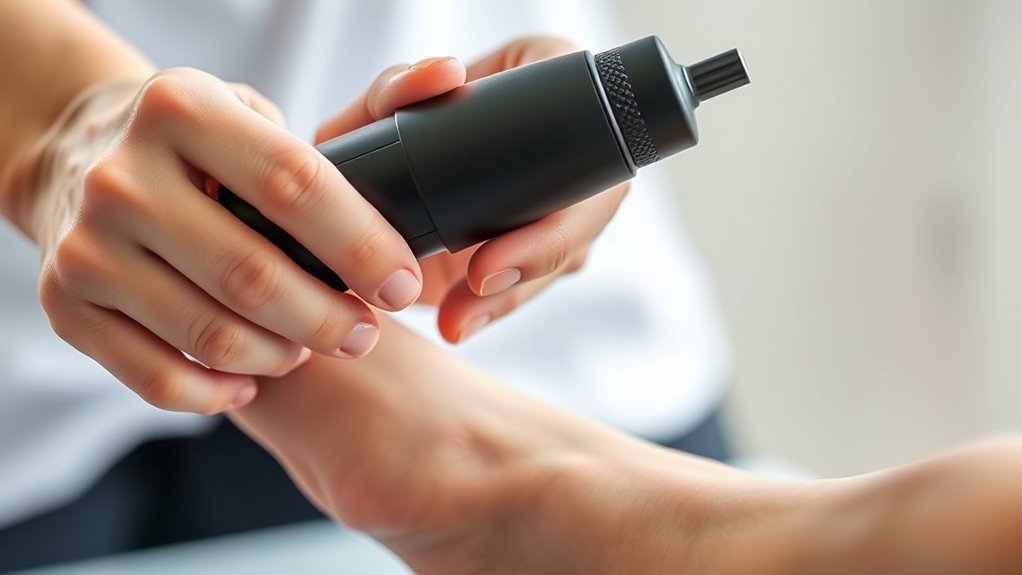
Many physiotherapists remain cautious about recommending massage guns for plantar fasciitis, primarily because scientific evidence supporting their effectiveness is limited. They see potential in using massage guns to target trigger points in the calf and foot muscles, which can help reduce tension and improve muscle relaxation. However, they emphasize that self-treatment with these devices should be approached carefully. Overuse or incorrect placement might worsen pain or cause injury. Physiotherapists often recommend combining massage gun therapy with other proven treatments, like stretching and manual therapy, rather than relying solely on it. They acknowledge that some patients find relief with massage guns, but stress the importance of proper technique and professional guidance to ensure safe and effective use. Additionally, understanding muscle relaxation techniques can enhance the benefits of treatment and prevent potential setbacks.
Proper Techniques and Precautions When Using a Massage Gun
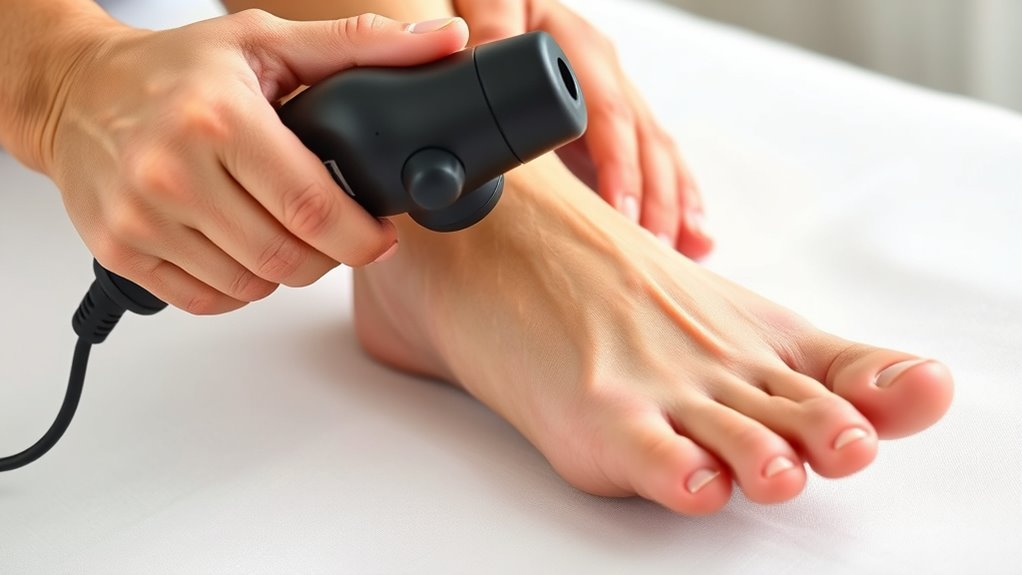
Using a massage gun safely and effectively requires understanding proper techniques and precautions. First, prioritize equipment safety by inspecting your device for damage before each use. Always start with the lowest setting to gauge comfort and avoid overstimulation. Keep the massage gun moving steadily over the affected area; holding it in one spot can cause tissue irritation. Focus on user comfort—if you experience pain or increased discomfort, stop immediately. Avoid using the device directly on bony areas, swollen spots, or open wounds. Be cautious around sensitive zones like the Achilles tendon. Limit sessions to about 1-2 minutes per area to prevent overuse. Following these guidelines helps maximize benefits while minimizing risks, ensuring a safe, effective massage experience. Additionally, understanding Bitcoin IRA strategies can assist in diversifying your investments and managing market risks effectively.
Complementary Treatments to Consider Alongside Massage Therapy
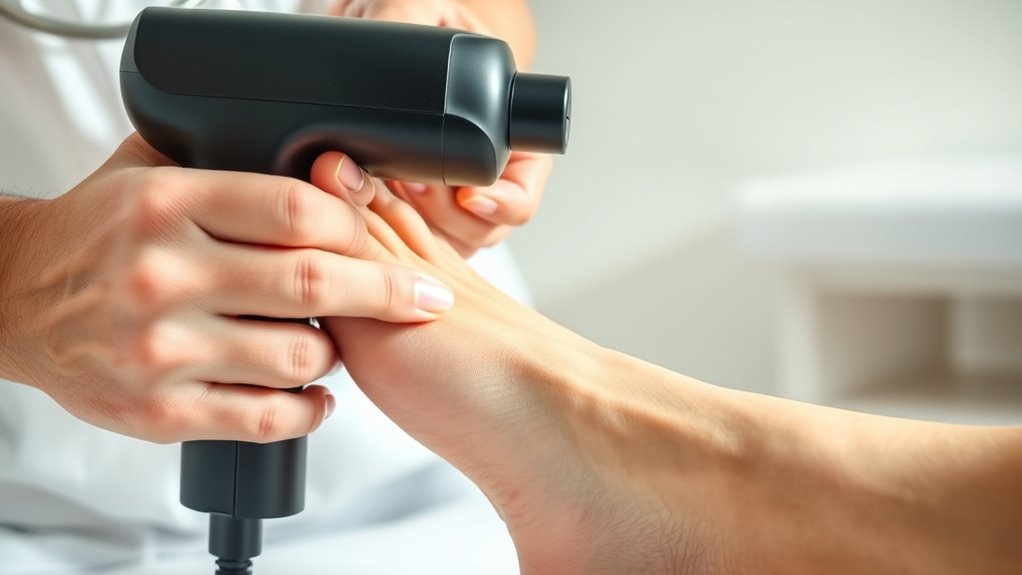
Incorporating complementary treatments alongside massage therapy can enhance recovery from plantar fasciitis and reduce symptoms more effectively. Adding stretching routines helps loosen tight fascia and calf muscles, improving flexibility and decreasing strain. Orthotic devices provide arch support, redistributing pressure away from painful areas and promoting healing. Combining these with massage therapy creates a comprehensive approach to relief. Digital literacy programs can also empower patients to better understand and manage their treatment options.
Final Thoughts: Is a Massage Gun a Viable Option?
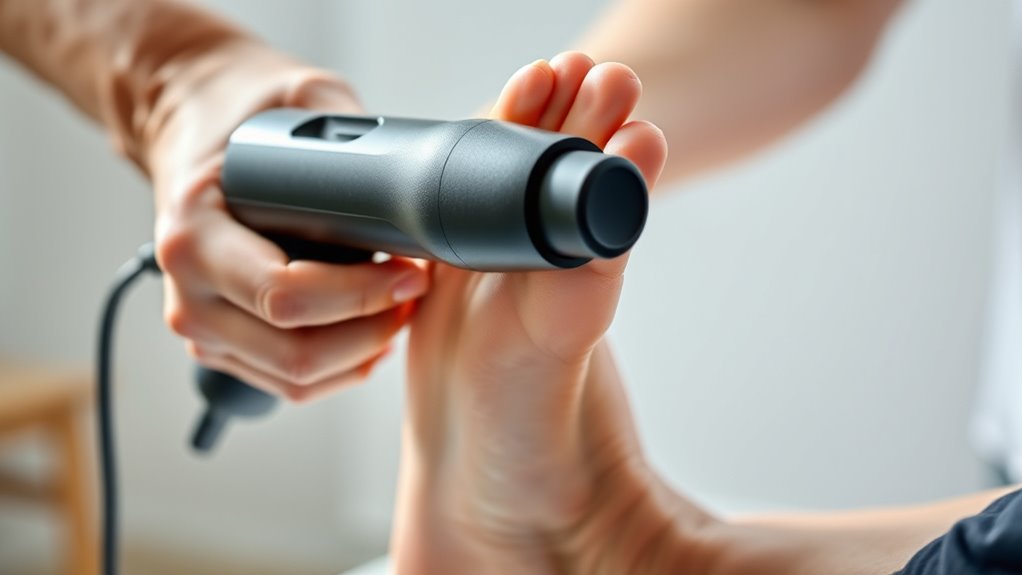
While combining massage therapy with stretching and orthotics can considerably ease plantar fasciitis symptoms, some people consider adding a massage gun to their recovery routine. However, it’s important to recognize the massage gun limitations. While it can provide temporary relief and target sore muscles, it isn’t a cure-all and may not address underlying issues like inflammation or structural problems. Relying solely on a massage gun could delay seeking professional treatment. For alternative pain relief, consider methods like physical therapy, proper footwear, and orthotics. A massage gun can be a helpful supplement, but it shouldn’t replace extensive care. Ultimately, consult a healthcare professional to determine if a massage gun is suitable for your specific condition and to avoid potential misuse or injury. Additionally, understanding air purifier maintenance can be beneficial for creating a healthy environment that supports recovery.
Frequently Asked Questions
Can Massage Guns Prevent Plantar Fasciitis From Developing?
A massage gun alone can’t prevent plantar fasciitis, but it can be part of your preventative care routine. By using it for foot and calf massage, you help reduce tension and improve circulation, supporting foot health. Combine this with foot strengthening exercises to boost resilience. Regular use can aid in maintaining flexibility and preventing strain, but don’t rely solely on a massage gun—consistent foot care and strengthening are key.
Are There Specific Massage Gun Settings Ideal for Foot Therapy?
You should look for a massage gun with adjustable speed and intensity settings to find the ideal foot therapy. Ensuring device compatibility with your foot size and sensitivity helps maximize user comfort. Start with gentle, low settings and gradually increase if needed, paying attention to how your foot responds. This approach helps target tight muscles or fascia effectively while keeping your comfort a priority during use.
How Long Should I Use a Massage Gun on My Foot?
Imagine your foot is a delicate garden needing gentle tending. For ideal usage time, use your massage gun on your foot for about 1-2 minutes per area, ensuring you avoid overdoing it. Focus on tender, sore spots, but don’t rush. The key is patience—think of it as nurturing your garden so it can flourish. Always listen to your body’s signals for the best foot massage duration.
Can Massage Guns Replace Professional Physical Therapy for Plantar Fasciitis?
You might think a massage gun can replace professional therapy, but DIY solutions and home remedies aren’t enough for plantar fasciitis. While a massage gun can offer temporary relief, it doesn’t address underlying issues like a physical therapist does. You should see a professional to develop a personalized treatment plan, ensuring proper healing and preventing future problems. Relying solely on a massage gun isn’t a substitute for expert care.
Are There Any Risks of Using a Massage Gun on My Foot?
Imagine your foot as a delicate garden needing gentle tending. Using a massage gun, you risk potential nerve damage if pressed too hard or on sensitive areas. Skin irritation is another concern, especially if the device causes discomfort or redness. Always keep the gun at a safe distance from bones and nerves, and listen to your body’s signals. When in doubt, consult a professional to avoid turning your healing into harm.
Conclusion
While a massage gun can offer some relief, it’s not a magic wand for plantar fasciitis. Think of it as a helpful tool in your wellness toolbox, but not the whole solution. To truly heal, combine it with proper stretches, footwear, and professional guidance. Listen to your body like a wise old friend, and don’t rely solely on gadgets. With patience and a balanced approach, you’ll walk comfortably again—step by step.
